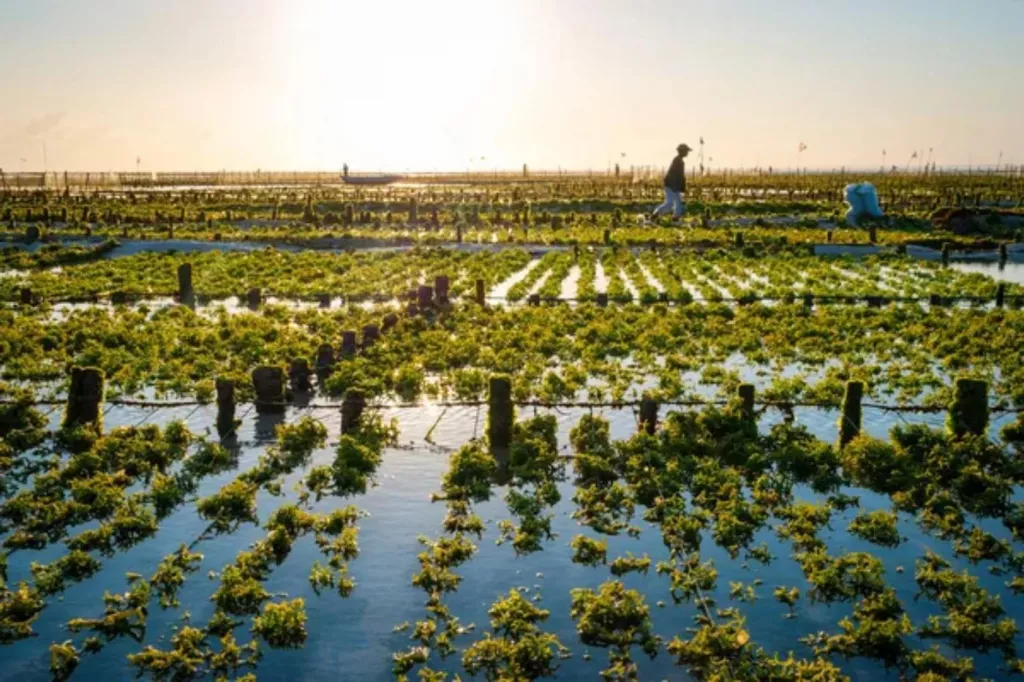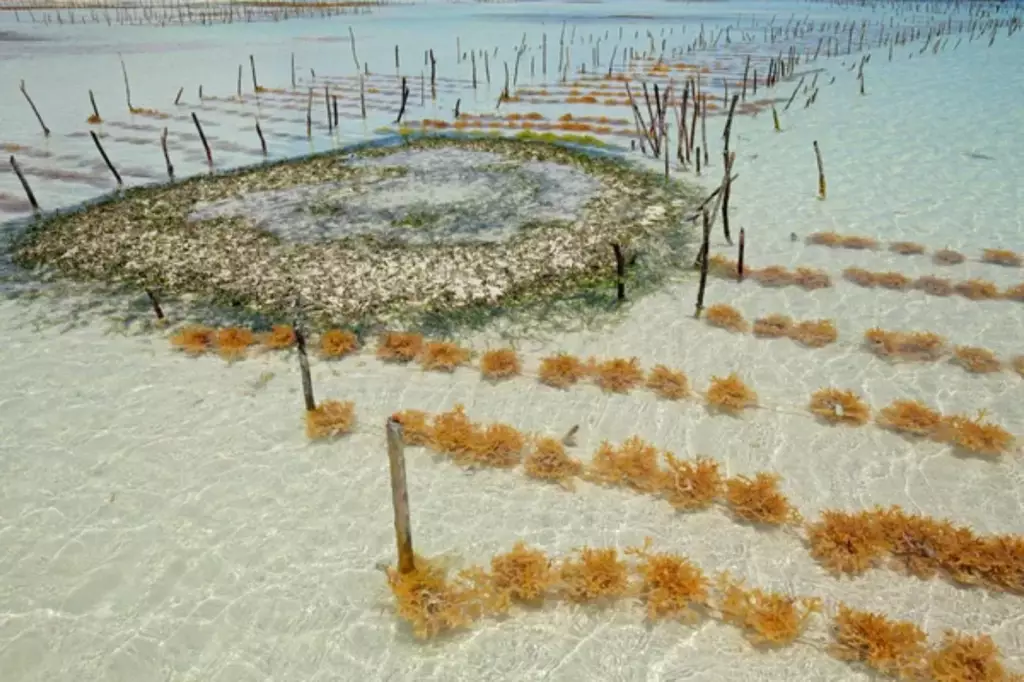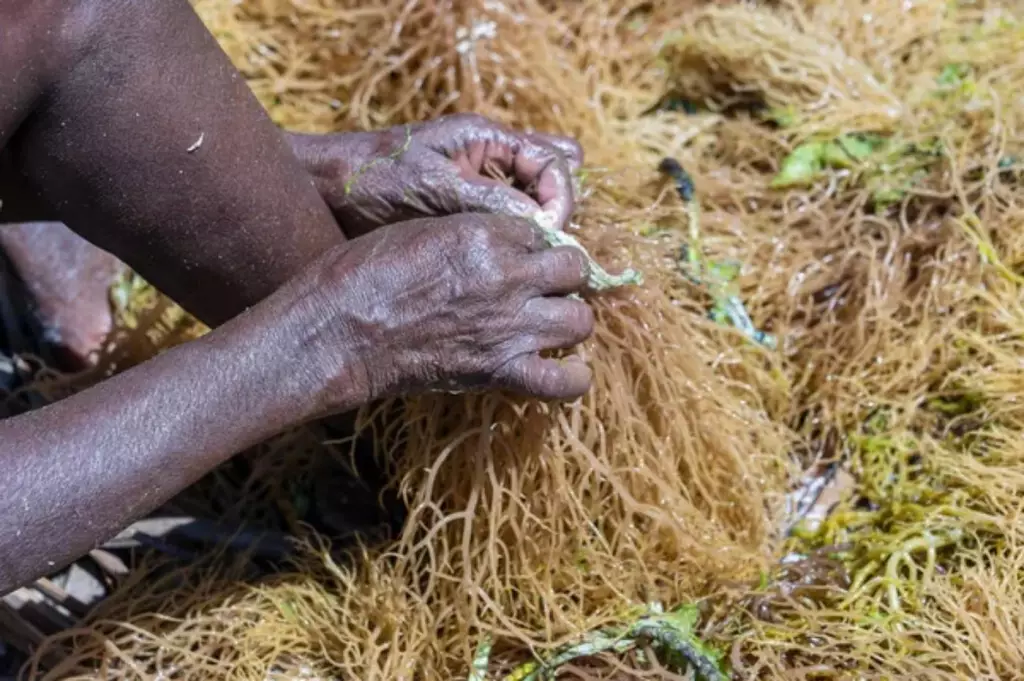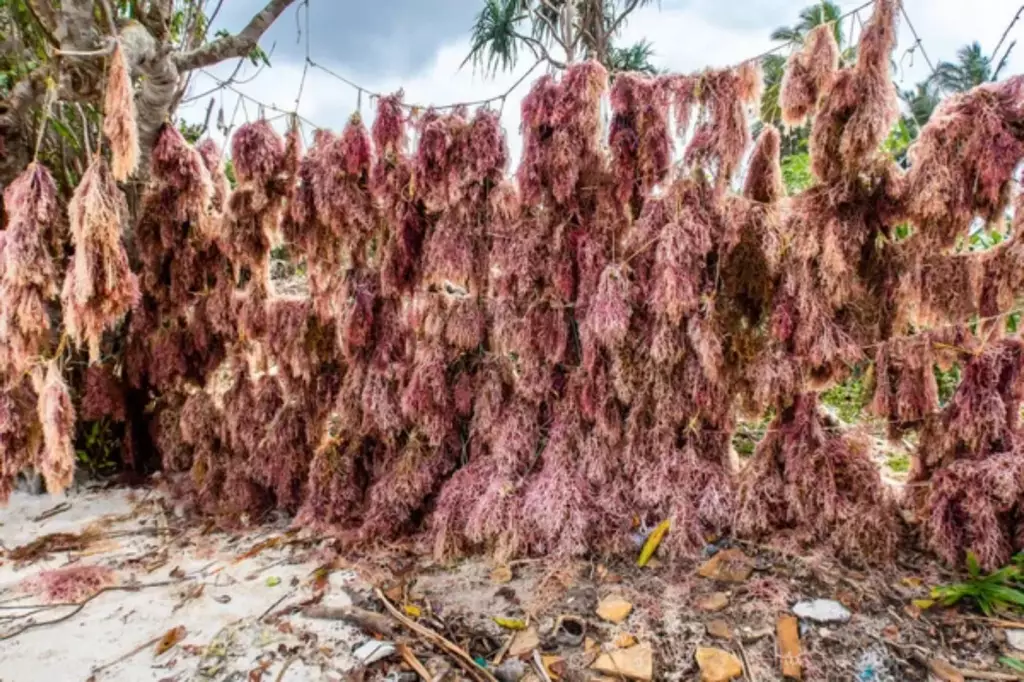Is Seaweed Farming Profitable? (2024 Potential)
Seaweed farming has garnered attention for its potential profitability in 2024. This sustainable practice, which involves cultivating various types of seaweed, offers promising economic benefits due to growing market demand and its environmentally friendly nature. In this article, we will examine the profitability and future prospects of seaweed farming.
Seaweed farming holds the potential for strong profit margins in 2024. Considering a conservative price of $0.50 per kilogram for dried seaweed, a farm with 320 lines can generate around $160 weekly, leading to a monthly net profit between $240 and $320.
Meanwhile, a larger farm with 480 lines can earn about $240 weekly, translating to a monthly net profit of $360 to $480, depending on costs. As you read further, you'll learn how much farmers make from cultivating seaweeds, and how much they invest to develop the farm.
Summary
- Larger farms, such as a 480-line farm, have a higher production capacity, which leads to increased weekly revenue (around $240) and monthly net profit ($360 to $480) compared to smaller farms like the 320-line farm.
- The profit margins for both 320-line and 480-line seaweed farms, range from 37.5% to 50%, demonstrating robust profitability and financial viability across various farm sizes, and highlighting the potential of seaweed farming as a lucrative business venture in 2024.
- Implementing innovative farming techniques, notably Integrated Multi-Trophic Aquaculture (IMTA), can significantly reduce operational costs by 10-30%.

On this page:
Profit Breakdown From Seaweed Farming
How much do seaweed farmers make?
There are many ways to make a small farm profitable, and one untapped potential is seaweed farming.
Seaweed cultivation can be a profitable venture, with revenue depending on factors such as farm size, the species of seaweed, and the efficiency of your operations. Here's what you might expect:
| Production Capacity (kg/week) | Revenue at $0.50/kg (per week) | Estimated Net Profit (per month) |
|---|---|---|
| 320 line farm | $160 | $240 - $320 |
| 480 line farm | $240 | $360 - $480 |
The table shows two scenarios based on the number of lines in a farm. A line is a structure used to grow seaweed.
-
A 320-line farm produces enough seaweed to generate $160 per week at a selling price of $0.50 per kg. For a 320-line farm, the monthly net profit ranges between $240 and $320.
-
A 480-line farm, being larger, produces more seaweed, leading to a weekly revenue of $240 at the same price per kg. Similarly, a 480-line farm can expect a higher net profit, ranging from $360 to $480 per month, due to its increased production capacity.

These figures indicate a direct correlation between the scale of the operation and profitability. Larger farms generally produce more seaweed, leading to higher revenue. However, this also implies greater initial investment and operating expenses.
Additionally, different species can have varying market values. Some species of seaweed might be more in demand due to their use in food, cosmetics, or pharmaceuticals.
Efficient operations, such as optimized growth conditions, effective harvest methods, and cost-effective transportation, can also significantly impact profitability.
Seaweed production is second only to freshwater fish in terms of global aquaculture volume, indicating substantial growth potential. Markets for seaweed are expanding, not just as food but also for applications in fertilizer, biofuels, and other industries.
Calculating potential profit margin from seaweed farming
Profit margins for seaweed farming can range from 20-60% depending on scale and location, with larger farms benefiting from economies of scale.
To calculate the profit margin, we can use the following formula:
Profit margin (%) = (Net profit/Total revenue) × 100
Let's use the following data:
- 320 line farm:
- Weekly revenue: $160
- Monthly revenue: $160 × 4 = $640
- Monthly net profit range: $240 to $320
- Profit margin calculation:
Lower profit margin: (240/640) ×100 = 37.5%
Upper profit margin: (320/640) ×100 = 50.0%
- 480 line farm:
- Weekly revenue: $240
- Monthly revenue: $240 × 4 = $960
- Monthly net profit range: $360 to $480
- Profit margin calculation:
Lower profit margin: (360/960) ×100 = 37.5%
Upper profit margin: (480/960) ×100 = 50.0%
In both cases, both the 320 and 480 line farms can achieve a profit margin between 37.5% to 50%, depending on their specific net profits.
These profit margins indicate a reasonably healthy profitability for both farm sizes, reflecting the potential financial viability of seaweed farming as a business venture in 2024.
Breakdown of Costs for Seaweed Farming
Initial investment to establish a seaweed farm
The table below provides a ballpark estimate of the costs involved in developing a seaweed farm:
| Initial Investment | Estimated Cost Range |
|---|---|
| Acquisition of seeds/spores | $100 - $1,000 |
| Setting up infrastructure (ropes, anchors, buoys) | $1,000 - $5,000 |
| Purchase or lease of land/water area | $500 - $10,000/year |
| Licenses and permits | $100 - $2,000 |
| Boats and equipment | $2,000 - $20,000 |
| Installation of nursery facilities | $500 - $5,000 |
| Staff training and hiring | $500 - $3,000 |
| Marketing and business setup costs | $500 - $5,000 |
Costs for acquiring seeds/spores
This involves purchasing the initial stock of seaweed seeds or spores to start the cultivation. You might want to purchase specific species like kelp, nori, or dulse, considering their market demand and growth conditions.
Costs to set up infrastructure
This includes the cost of ropes, anchors, and buoys needed to create the physical structure where seaweed will be cultivated. High-quality materials suited for marine conditions are recommended, affecting the cost.

Cost to purchase or lease of land/water area
Depending on the location, you may need to buy or lease a specific area of land or water for seaweed cultivation. Lease costs can vary with proximity to shore and local regulations.
Costs for licenses and permits
To legally operate a seaweed farm, you'll need to obtain various licenses and permits, which can vary by region and local regulations.
Costs to purchase boats and equipment
Essential for transportation and operational tasks, the cost of boats and other equipment will depend on the scale of your operations. Larger farms or those in deeper waters require more robust, and hence more expensive, equipment.
Cost of installing nursery facilities
This involves the cost of setting up nursery facilities for initial seaweed growth before transferring them to the main cultivation area, possibly including tanks and temperature regulation systems. Scale and technology used significantly influence costs.
Cost of hiring and training staff
Hiring skilled labor for cultivation, harvest, and maintenance, along with training for specific farming techniques and safety procedures. Costs depend on the level of expertise required and local wage rates.
Marketing and business setup costs
This covers the expenses for marketing your seaweed products and setting up the business, including branding, promotion, and administrative setup. Costs vary based on the chosen strategies and the scale of the business.
Operational expenses to maintain seaweed farm
| Operational Expense | Estimated Cost Range |
|---|---|
| Labor (managing and harvesting) | $1,000 - $5,000/month |
| Maintenance (equipment and facilities) | $500 - $2,000/month |
| Utilities (water, electricity, etc.) | $200 - $1,000/month |
| Seaweed seedlings replacement | $100 - $500/month |
| Transportation and logistics | $300 - $1,500/month |
| Insurance | $100 - $1,000/month |
| Marketing and sales | $200 - $1,000/month |
| Administrative expenses | $300 - $1,500/month |
Labor costs
This involves salaries for skilled workers who manage daily operations, maintain seaweed health, and perform harvesting. Costs vary based on staff size, local wage rates, and the complexity of tasks.
Costs for maintenance
Regular upkeep of boats, harvesting tools, ropes, buoys, and other farm equipment. Includes repair costs and replacement of worn-out parts, with expenses depending on the frequency of use and the harshness of the marine environment.
Payment for utilities
Covers the cost of utilities like electricity for nursery facilities, fresh water for processing, and fuel for boats. Costs are influenced by local utility rates and the scale of usage.
Costs for replacing seaweed seedlings
Regular purchase of new seedlings to sustain production is especially important in cyclical or batch-based farming. The cost depends on the species of seaweed and the rate of growth and harvest.
Costs for transportation and logistics
Expenses related to transporting harvested seaweed to markets or processing centers. Includes fuel costs, vehicle maintenance, and possibly shipping fees, varying with the distance and volume of seaweed transported.
Costs of availing insurance
Protection against risks like equipment damage, crop failure, or accidents. Premiums vary based on the value of assets, the scope of the farm, and the specific risks covered.
Costs for marketing and sales
Costs associated with promoting the seaweed products, and might include online advertising, attending trade shows, and producing marketing materials. Expenses depend on the chosen strategies and tools.
Administrative expenses
Day-to-day office expenses such as stationery, software subscriptions for farm management, and administrative staff salaries. Varies with the size of the operation and the extent of administrative activities.
Key Aspects Affecting Seaweed Farm Profits
Environmental factors affect seaweed cultivation
Seaweed cultivation relies heavily on the climate and health of marine ecosystems. Your farm's location will dictate the types of seaweed that can thrive, with species like kelp and red seaweed requiring specific conditions.

Healthy oceans support biodiversity, which is crucial for ecosystem services needed for sustainable seaweed production. Remember, climate change can affect sea temperatures and storm frequency, impacting your farm's productivity.
| Climate Condition | Suitable Seaweed Types | Potential Yield Impact |
|---|---|---|
| Cooler temperatures | Kelp, macroalgae | Higher productivity |
| Warmer temperatures | Red seaweed | Varies with species |
The effect of market dynamics
The seaweed market is dynamic, with farmed seaweed and wild harvest products catering to different demands. Hydrocolloids such as agar, alginate, and carrageenan sourced from seaweed are in steady demand for various industries, shaping the market.
Innovations and new applications for seaweed-based products also create opportunities for you as an entrepreneur to engage with investors and explore new markets.
Farm efficiency and yield are impacted by production techniques
Advanced methods in macroalgae cultivation and improved photosynthesis efficiency can boost your output, while developing bioactive compounds may increase the value of your harvest. Embracing innovation often requires investment but can lead to higher profitability.
Geographical considerations are vital
For instance, seaweed farming in the Pacific, European coastal areas, or Asian countries all present different scenarios.
In places like Alaska or by the Ocean Rainforest, cooler waters may suit certain seaweed types better, whereas in the U.S., you might find a larger domestic market for your products. Your proximity to customers and shipping routes can also affect your bottom line.
Cost-Saving Strategies for Seaweed Farming
To tap into the profitability of seaweed farming in 2024, your attention to cost efficiency and diverse income streams is crucial. Embracing innovative farming practices and sustainable development are keys to bolstering your bottom line.
| Strategy | Impact on Profits from Seaweed Farming |
|---|---|
| Adapt innovative farming practices (IMTA) | Reduction of 10-30% on costs |
| Effective resource management | Reduction of 5-15% on water costs, and 20-25% reduced costs for seed stock |
| Engage in sustainability programs | Increase of 5-10% of gross income through carbon credits |
| Diversify income streams | Increases profit margin by 40-50% |
Adapt innovative farming practices
Your adoption of innovative farming practices can significantly save on operational costs. Techniques such as integrated multi-trophic aquaculture (IMTA) allow for resource recycling and greater yield, reducing the need for feeds, fertilizers, and other inputs. This technique is also often used in salmon farming.
Estimated cost savings range:
- Traditional vs. IMTA: 10-30%
Focus on effective resource management
Effective resource management can lead to marked improvements in your farm's cost efficiency. You should focus on the efficient use of resources such as water and seed stock, which not only minimizes costs but also supports sustainable seaweed aquaculture.
Estimated cost savings range:
- Water recycling: 5-15%
- Seed stock optimization: 20-25%
Engage in sustainability programs
You can engage in sustainability programs like carbon sequestration projects, which may provide additional revenue through carbon credits.
These eco-friendly practices can enhance your economic and environmental benefits, making your enterprise a part of climate solutions.
Projected additional revenue:
- Carbon credits: 5-10% of gross income
Diversify income streams
Diversified income streams bolster your seaweed farm's profitability. By venturing into market diversification with seaweed-based products, including biofuels, cosmetics, and functional foods, you can create a buffer against market fluctuations and increase your profit margins.
-
Seaweed product lines and their estimated profit margin increase:
- Biofuels: +15%
- Cosmetics: +25%
- Functional foods: +20%
-
Estimated calculation of net profit and profit margin increase:
- Before diversification: Net profit margin: 20-30%
- After diversification: Net profit margin: 40-50%
Industry Demand for Seaweed
The demand for seaweed has increased substantially, helped by its versatility in various applications. You'll find seaweed in:
| Industry | Estimated Demand for Seaweed (%) |
|---|---|
| Food industry | 40% |
| Agriculture | 20% |
| Cosmetic industry | 15% |
| Biomedical research | 10% |
| Biofuel production | 15% |
- The food industry, as a healthy ingredient rich in nutrients with a growing vegetarian and vegan market looking for alternatives.
- Agriculture, as an organic fertilizer and soil conditioner.
- The cosmetic industry, where it's used for its hydrating properties and natural extracts.
- Biomedical research for developing new pharmaceuticals.
- Biofuel production, looking at seaweed as a potential sustainable energy source.
In recent years, the global appetite for seaweed has grown. Countries previously unfamiliar with seaweed as part of their culinary traditions are now adding it to their diets.
The expanding uses of seaweed have led to a rise in market value. Projections suggest that the seaweed market could reach significant figures in upcoming years due to its broad utility.
Investing in Seaweed Farming
To begin investing in seaweed farming, you should explore the market and understand the driving forces behind the industry.
Seaweed farming has applications in food, cosmetics, and pharmaceuticals, with growth opportunities identified in markets that could increase in value significantly by 2030.

Investment avenues in seaweed farming
- Direct investment: If you're interested in a hands-on approach, consider directly investing in a seaweed farm. This could involve purchasing or leasing aquatic land and hiring a workforce.
- Stocks and shares: For a more hands-off investment, look into companies that specialize in seaweed farming or those that utilize seaweed in their products.
- Venture capital: Support innovative startups working to advance seaweed cultivation technologies or sustainable business models.
Financial considerations before starting a seaweed farm
- Start-up costs: Initial investment ranges extensively depending on the scale.
| Scale | Estimated Initial Cost |
|---|---|
| Small | $5,000 - $20,000 |
| Large | $100,000+ |
- Operating expenses: These may include labor, maintenance, and harvest costs.
- Sales revenue: Highly variable; influenced by species grown and market demand.
- Estimated profits:The estimated net profit margin from seaweed farms can range from 10% to 40%, impacted by factors such as scale, efficiency, and market prices.


